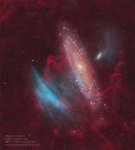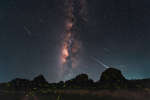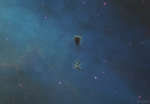
|
Astronomy Picture Of the Day (APOD)
 APOD: 2025 August 8 B Dawn of the Crab
APOD: 2025 August 8 B Dawn of the Crab
8.08.2025
One of the all-time historic skyscapes occured in July 1054, when the Crab Supernova blazed into the dawn sky. Chinese court astrologers first saw the Guest Star on the morning of 4 July 1054 next to the star Tianguan (now cataloged as Zeta Tauri).
 APOD: 2025 August 7 B The Double Cluster in Perseus
APOD: 2025 August 7 B The Double Cluster in Perseus
7.08.2025
This stunning starfield spans about three full moons (1.5 degrees) across the heroic northern constellation of Perseus. It holds the famous pair of open star clusters, h and Chi Persei. Also cataloged...
 APOD: 2025 August 6 B Meteor before Galaxy
APOD: 2025 August 6 B Meteor before Galaxy
6.08.2025
What's that green streak in front of the Andromeda galaxy? A meteor. While photographing the Andromeda galaxy in 2016, near the peak of the Perseid Meteor Shower, a small pebble from deep space crossed right in front of our Milky Way Galaxy's far-distant companion.
 APOD: 2025 August 5 B NGC 6072: A Complex Planetary Nebula from Webb
APOD: 2025 August 5 B NGC 6072: A Complex Planetary Nebula from Webb
5.08.2025
Why is this nebula so complex? The Webb Space Telescope has imaged a nebula in great detail that is thought to have emerged from a Sun-like star. NGC 6072 has been resolved into one of the more unusual and complex examples of planetary nebula.
 APOD: 2025 August 4 B Blue Arcs Toward Andromeda
APOD: 2025 August 4 B Blue Arcs Toward Andromeda
4.08.2025
What are these gigantic blue arcs near the Andromeda Galaxy (M31)? Discovered in 2022 by amateur astronomers, the faint arcs -- dubbed SDSO 1 -- span nearly the same angular size as M31 itself. At first, their origin was a mystery: are they actually near the Andromeda Galaxy, or alternatively near to our Sun?
 APOD: 2025 August 3 B Milky Way and Exploding Meteor
APOD: 2025 August 3 B Milky Way and Exploding Meteor
3.08.2025
In about a week the Perseid Meteor Shower will reach its maximum. Grains of icy rock will streak across the sky as they evaporate during entry into Earth's atmosphere. These grains were shed from Comet Swift-Tuttle.
 APOD: 2025 August 2 B Fireflies, Meteors, and Milky Way
APOD: 2025 August 2 B Fireflies, Meteors, and Milky Way
2.08.2025
Taken on July 29 and July 30, a registered and stacked series of exposures creates this dreamlike view of a northern summer night. Multiple firefly flashes streak across the foreground as the luminous Milky...
 APOD: 2025 August 1 B Small Dark Nebula
APOD: 2025 August 1 B Small Dark Nebula
1.08.2025
A small, dark, nebula looks isolated near the center of this telescopic close-up. The wedge-shaped cosmic cloudlet lies within a relatively crowded region of space though. About 7,000 light-years distant and filled with glowing gas and an embedded cluster of young stars, the region is known as M16 or the Eagle Nebula.
 APOD: 2025 July 31 B Supernova 2025rbs in NGC 7331
APOD: 2025 July 31 B Supernova 2025rbs in NGC 7331
31.07.2025
A long time ago in a galaxy 50 million light-years away, a star exploded. Light from that supernova was first detected by telescopes on planet Earth on July 14th though, and the extragalactic transient is now known to astronomers as supernova 2025rbs.
 APOD: 2025 July 30 B Coronal Loops on the Sun
APOD: 2025 July 30 B Coronal Loops on the Sun
30.07.2025
Our Sun frequently erupts in loops. Hot solar plasma jumps off the Sun's surface into prominences, with the most common type of prominence being a simple loop. The loop shape originates from the Sun's magnetic field, which is traced by spiraling electrons and protons.
|
January February March April May June July August |
|||||||||||||||||||||||||||||||||||||||||||||||||